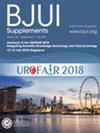非肌肉浸润性膀胱癌累及膀胱颈部:卡介苗与吉西他滨/多西他赛的风险含义和结果
IF 3.7
2区 医学
Q1 UROLOGY & NEPHROLOGY
引用次数: 0
摘要
目的评估膀胱颈部受损伤(BNI)对非肌肉浸润性膀胱癌(NMIBC)肿瘤预后的影响,并比较该人群中卡介苗(BCG)和吉西他滨/多西他赛(Gem/Doce)膀胱内治疗的结果。患者和方法我们分析了2013年至2023年连续接受经尿道膀胱肿瘤切除术(turt)并接受BCG或Gem/Doce治疗的NMIBC患者。BNI定义为TURBT期间膀胱颈部出现肿瘤。采用Kaplan-Meier和Cox回归分析评估无复发生存期(RFS)和无进展生存期(PFS)。结果474例患者中,58例(12%)有BNI。中位(四分位间距)随访时间为34(12-58)个月。BNI组的2年RFS在任何级别(41% vs 57%, log-rank p = 0.003)和高度复发(56% vs 68%, log-rank p = 0.03)均较低。BNI独立预测较差的任何级别RFS(风险比[HR] 1.59, p = 0.02)、高级RFS(风险比[HR] 1.68, p = 0.03)和PFS(风险比[HR] 2.18, p = 0.03)。虽然BCG和Gem/Doce具有相当的2年高级别RFS (59% vs 53%, log-rank p = 0.31)和PFS (88% vs 68%, log-rank p = 0.07),但多变量分析显示,任何级别复发的风险(HR 1.75, p < 0.001)和进展的风险(HR 2.72, p = 0.002)均显著增加。维持治疗改善了高级别RFS (HR 0.43, p < 0.001)和PFS (HR 0.44, p = 0.003)。局限性包括回顾性设计和单一机构的数据。结论膀胱颈部受累是NMIBC患者预后较差的独立预测因子。虽然未经调整的结果相似,但多变量分析显示Gem/Doce的复发和进展风险更高。认识到BNI是高危因素,可以完善风险分层和治疗决策。需要进一步的研究来验证这些发现。本文章由计算机程序翻译,如有差异,请以英文原文为准。
Bladder neck involvement in non-muscle-invasive bladder cancer: risk implications and outcomes of BCG vs gemcitabine/docetaxel.
OBJECTIVES
To evaluate the impact of bladder neck involvement (BNI) on oncological outcomes in non-muscle-invasive bladder cancer (NMIBC) and compare outcomes between Bacillus Calmette-Guérin (BCG) and gemcitabine/docetaxel (Gem/Doce) intravesical therapies in this population.
PATIENTS AND METHODS
We analysed consecutive patients with NMIBC who underwent transurethral resection of bladder tumour (TURBT) and received BCG or Gem/Doce from 2013 to 2023. BNI was defined as tumour presence at the bladder neck during TURBT. Recurrence-free survival (RFS) and progression-free survival (PFS) were assessed using Kaplan-Meier and Cox regression analyses.
RESULTS
Among 474 patients, 58 (12%) had BNI. The median (interquartile range) follow-up time was 34 (12-58) months. The 2-year RFS was lower in the BNI group for any-grade (41% vs 57%, log-rank p = 0.003) and high-grade recurrence (56% vs 68%, log-rank p = 0.03). BNI independently predicted worse any-grade RFS (hazard ratio [HR] 1.59, p = 0.02), high-grade RFS (HR 1.68, p = 0.03), and PFS (HR 2.18, p = 0.03). While BCG and Gem/Doce had comparable 2-year high-grade RFS (59% vs 53%, log-rank p = 0.31) and PFS (88% vs 68%, log-rank p = 0.07), the multivariable analysis revealed significantly increased risk of any-grade recurrence (HR 1.75, p < 0.001) and progression (HR 2.72, p = 0.002). Maintenance therapy improved high-grade RFS (HR 0.43, p < 0.001) and PFS (HR 0.44, p = 0.003). Limitations include retrospective design and single-institution data.
CONCLUSION
Bladder neck involvement is an independent predictor of worse outcomes in NMIBC. While unadjusted outcomes were similar, multivariable analysis showed higher recurrence and progression risk with Gem/Doce. Recognising BNI as a high-risk factor may refine risk stratification and treatment decisions. Further studies are needed to validate these findings.
求助全文
通过发布文献求助,成功后即可免费获取论文全文。
去求助
来源期刊

BJU International
医学-泌尿学与肾脏学
CiteScore
9.10
自引率
4.40%
发文量
262
审稿时长
1 months
期刊介绍:
BJUI is one of the most highly respected medical journals in the world, with a truly international range of published papers and appeal. Every issue gives invaluable practical information in the form of original articles, reviews, comments, surgical education articles, and translational science articles in the field of urology. BJUI employs topical sections, and is in full colour, making it easier to browse or search for something specific.
 求助内容:
求助内容: 应助结果提醒方式:
应助结果提醒方式:


